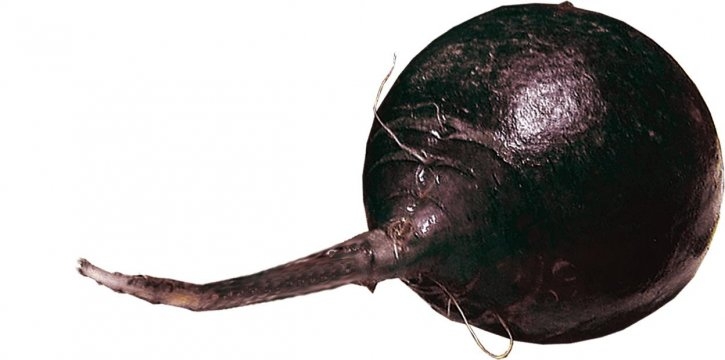Description
The black radish or Spanish radish is a biennial herbaceous plant of the Brassicaceae family, with a large taproot and white, crunchy and juicy flesh, with a bitter taste and more pungent than other varieties of radishes. It is covered with a rough, black, sometimes purple skin. The leaves are very serrated and slightly hairy. It has very branched flower stalks up to 60-80 cm high.
Part used
The root.
Active principles
-Essential oil, very volatile. It contains sulfur compounds (0.0025%), among which are the glucosinolates, compounds that give the characteristic odor of most of the Brassicaceae.
- 3-indol-methylglucosinolate, which by the action of the enzyme myrosinase generates E-4-methylthio-3-butenyl isothiocyanate.
- sulforalenes and allyl isothiocyanate, resulting from the degradation of glucorraphanine and synigroside.
- glucobrassicin, sinapine, butyl isothiocyanate, raphanol, pelargonidin derivatives, methylmercaptan and glucoputranjivine.
-Other compounds: anthocyanosides, small amounts of vitamins C and B, folates, minerals calcium, potassium, phosphorus, iodine, iron, magnesium, fiber and enzymes (oxidases and peroxidases).
Pharmacological action
- Aperitif.
- Digestive.
- Hepatoprotective.
- Choleretic and cholagogue.
- Laxative by stimulation of intestinal peristalsis.
- On the respiratory tract has expectorant and balsamic action.
- Diuretic.
- Antitumor: induces apoptosis in tumor cells, inhibits angiogenesis.
Indications
- Dyspepsia.
- Biliary dyskinesias.
- Hepatic affections.
- Habitual consumption of alcohol, medicines.
- Unbalanced diet: rich in fats, processed products, etc.
- Colds, bronchitis.
Contraindications
- Pregnancy and lactation.
- Biliary tract obstruction.
Precautions
Patients with hypothyroidism. Although it has not been described in the case of black radish, some glucosinolates present antithyroid action, so it could affect the normal function of the gland.
Drug interactions
They have not been described.
Side effects
They have not been described at the recommended doses.
Bibliography
-.Ahn M, Kim J, Choi Y, Ekanayake P, Chun JY, et al. Fermented Raphanus sativus attenuates nonalcoholic fatty liver disease in mice. September 9, 2019. Food Sci Nutr. 2019 Oct. 7103327-3337
-.Ahn M, Kim J, Hong S, Kim J, et al.Black Radish (Raphanus sativus L. var. niger) Extract Mediates Its Hepatoprotective Effect on Carbon Tetrachloride-Induced Hepatic Injury by Attenuating Oxidative Stress. J Med Food. 2018 Aug 1; August 1, 2018.
-.Evans M, Paterson E, Barnes DM. Efficacy of Spanish black radish in detoxification of toxins in the liver. BMC Complement Altern Med. 2014;14:475
-.Castro-Torres IG, De la O-Arciniega M, Gallegos-Estudillo J, et al Raphanus sativus L. var niger for the Prevention of Cholesterol Gallstones. Phytother Res. 2013 Mar 15
-.Ahn M, Kim J, Hong S, Kim J, Ko H, et al. Black Radish (Raphanus sativus L. var. niger) Extract Mediates Its Hepatoprotective Effect on Carbon Tetrachloride-Induced Hepatic Injury by Attenuating Oxidative Stress. J Med Food. 2018 Aug 1.
